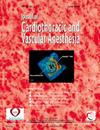先天性心脏病患者接受心脏手术、心导管插入术和心脏成像时心脏骤停的描述和处理。
IF 2.1
4区 医学
Q2 ANESTHESIOLOGY
Journal of cardiothoracic and vascular anesthesia
Pub Date : 2025-07-22
DOI:10.1053/j.jvca.2025.07.031
引用次数: 0
摘要
目的:描述小儿心脏麻醉师为先天性心脏病患者提供的麻醉护理期间心脏骤停的情况,并确定预后的预测因素。设计:回顾性图表回顾。单位:第四儿童医院。参与者:2016年1月至2022年12月期间接受心脏手术或影像学检查的先天性心脏病患者干预措施:无。测量结果和主要结果:76例患者在麻醉护理期间发生心脏骤停。患者年龄中位数为424天(四分位间距[IQR], 75-4596天),体重中位数为7.6 kg (IQR, 4.7-44.1 kg)。25例患者有单心室生理(34%),50例患者全身心室功能正常(66%)。43例(57%)心导管实验室发生心脏骤停,25例(33%)心脏手术室发生心脏骤停。在手术过程中最常发生心脏骤停(n = 60;79%)。病因为心律失常29例(38%),低心输出量或缺血21例(28%)。心肺复苏(CPR)的中位持续时间为4分钟(IQR, 1-11分钟)。31名患者(44%)接受了标准剂量的肾上腺素(10µg/kg或1 mg), 25名患者(33%)需要体外膜氧合(ECMO)。7天内死亡或神经损伤18例(24%)。在多变量分析中,仅使用ECMO(调整优势比为16,95%置信区间为2.1-93.2;P = 0.006)与神经损伤或死亡的复合结局独立相关。结论:在儿科心脏麻醉师护理下发生心脏骤停的患者,心肺复苏术的中位持续时间为4分钟。7天内死亡或神经损伤的唯一独立预测因子是ECMO的使用。本文章由计算机程序翻译,如有差异,请以英文原文为准。
Description and Management of Cardiac Arrests in Congenital Cardiac Patients Undergoing Cardiac Surgery, Cardiac Catheterization, and Cardiac Imaging
Objective
To describe cardiac arrest during anesthesia care provided by a pediatric cardiac anesthesiologist in patients with congenital heart disease and identify predictors of outcome.
Design
Retrospective chart review.
Setting
Quaternary children’s hospital.
Participants
Patients with congenital cardiac disease undergoing cardiac procedures or imaging between January 2016 and December 2022
Interventions
None.
Measurements and Main Results
Seventy-six patients experienced cardiac arrest during anesthesia care. The median patient age was 424 days (interquartile range [IQR], 75-4596 days), and the median weight was 7.6 kg (IQR, 4.7-44.1 kg). Twenty-five patients had single ventricle physiology (34%), and 50 patients had normal systemic ventricular function (66%). Cardiac arrest occurred in the cardiac catheterization laboratory in 43 patients (57%) and in the cardiac operating room in 25 patients (33%). Cardiac arrest occurred most frequently during the procedure (n = 60; 79%). The etiology was arrhythmia in 29 patients (38%) and low cardiac output or ischemia in 21 patients (28%). The median duration of cardiopulmonary resuscitation (CPR) was 4 minutes (IQR, 1-11 minutes). Thirty-one patients (44%) received a code dose of epinephrine (10 µg/kg or 1 mg), and 25 patients (33%) required extracorporeal membrane oxygenation (ECMO). Death or neurologic injury within 7 days occurred in 18 patients (24%). On multivariable analysis, only the use of ECMO (adjusted odds ratio, 16, 95% confidence interval, 2.1-93.2; p = 0.006) was independently associated with the composite outcome of neurologic injury or death.
Conclusions
Patients who experienced cardiac arrest while under the care of a pediatric cardiac anesthesiologist had a median CPR duration of 4 minutes. The sole independent predictor of death or neurologic injury within 7 days was the use of ECMO.
求助全文
通过发布文献求助,成功后即可免费获取论文全文。
去求助
来源期刊
CiteScore
4.80
自引率
17.90%
发文量
606
审稿时长
37 days
期刊介绍:
The Journal of Cardiothoracic and Vascular Anesthesia is primarily aimed at anesthesiologists who deal with patients undergoing cardiac, thoracic or vascular surgical procedures. JCVA features a multidisciplinary approach, with contributions from cardiac, vascular and thoracic surgeons, cardiologists, and other related specialists. Emphasis is placed on rapid publication of clinically relevant material.

 求助内容:
求助内容: 应助结果提醒方式:
应助结果提醒方式:


